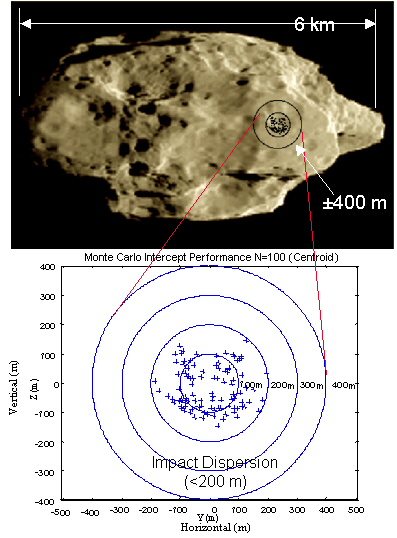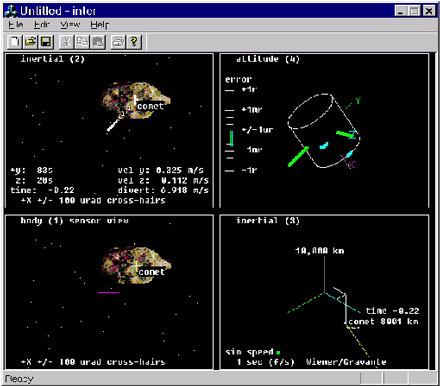The greatest challenge for the Deep Impact mission and Ball Aerospace & Technologies Corp. (since they are building the instruments and spacecrafts) is to target and successfully hit comet Tempel 1. Traveling at a relative velocity of 10 km/s and from about 864,000 km (536,865 miles) away, the impactor must strike the 6 km (3.7 mile) diameter comet. The impact area must be well lit to allow the science instruments to take images of the impact and its aftermath.
Ball Aerospace & Technologies Corp. is building the Impactor and the Impactor Targeting Sensor that it carries. It will employ Autonav software developed by Jet Propulsion Laboratory for Deep Space 1 that is tailored for Deep Impact. The combination is unique in creating a separate "smart" spacecraft specifically to target and hit Tempel 1.
The impactor acquires guidance data by measuring its flight path relative to the background stars and Tempel 1's nucleus using optical measurements with an accuracy of better than 1 µrad. The system controls its flight path with an accuracy of 1mm/s (1 sigma) by using hydrazine thrusters. The impactor carries 15 m/s of delta-V capability, which provides tremendous leverage in correcting the small crosstrack offsets expected after separation.
A detailed 6-degree-of-freedom simulation tool developed by Ball Aerospace & Technologies Corp. has been used to study the impactor concept. This extremely high-fidelity simulation models impactor attitude and position control systems, including environmental disturbances. The simulation's Monte Carlo approach also models the following:
| Actuator Characteristics: | Motion effects of the thruster minimum impulse bit plus thruster force-to-torque and torque-to-force cross-coupling |
| Sensor Characteristics: | Including expected dynamic measurement noise on comet approach |
| Attitude and Position Control: | Including system gains, timing, latencies |
| Comet Characteristics: | Center of brightness motion given nucleus irregularities, rotation, illumination |
| Trajectory Propagation: | Of both impactor and comet |
The figure below shows the results of 100 Monte Carlo simulations of impactor targeting, with target offsets measured from the center of brightness (CB). Extremely accurate targeting is indicated by the small values of the mean offset (<100 m). All 100 samples in this simulation impacted within 200 m of the CB. Fuel use is also well within the impactor capabilities, with the mean less than one third of the 15 m/s capability.
 |
| Impactor simulation results show accurate targeting capability to the nucleus center of brightness. (100 Monte Carlo simulations) |
In the actual implementation, a targeting offset will be included to aim the impactor between the center of mass and the center of brightness. This is to ensure that the impactor is not aimed too close to the bright limb on the sunward side of the nucleus, nor too close to the terminator.
 |
| You may download a copy of the simulation and run it on your on computer (PC only). |
The lower left screen is a body view of the comet, jumping around with thruster fire (more than currently expected) - press 1 to toggle through options - nominally leave at base option.
The upper left screen is an inertial view of the comet - press 2 to toggle through options - nominally press once to get maximum zoom. The lower right screen is a geometric view of the comet and impactor - press 3 to toggle between inertial and body view - nominally leave at base option.
The upper right screen is a body attitude view of the impactor showing thruster fire and attitude errors.
Pressing F will speed up the simulation while pressing S will slow it down - there are 3 settings.











